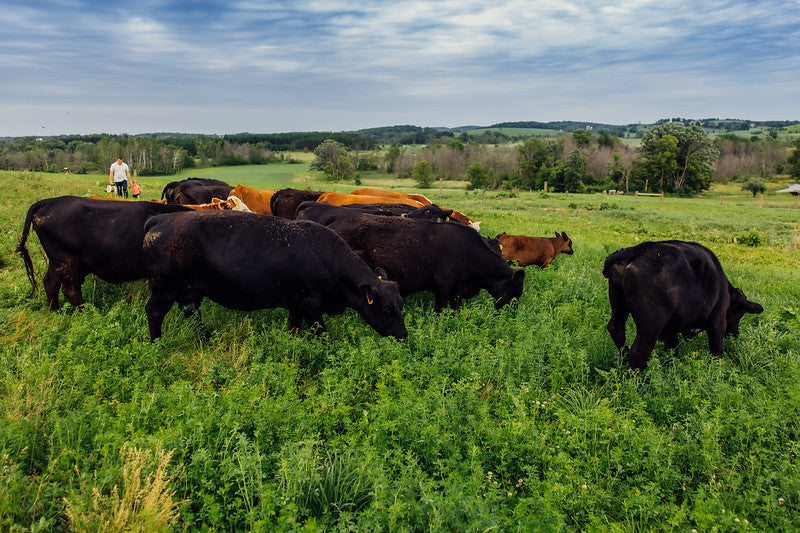
All About Grass-Fed Beef: Answering Common Questions
Share
Grass-fed beef has become increasingly popular as consumers seek healthier and more sustainable meat options. Whether you're new to grass-fed beef or looking for more details, we're here to answer some of the most commonly searched questions.
What is Grass-Fed Beef?
Grass-fed beef comes from cattle that graze on grass and forage for most of their lives. They munch on a variety of different plants every day and those plants change depending on the time of year, weather, and the area of pasture they are in. Grass-fed beef can be grass-finished as well, which means it only consumed plants in the pasture. It can also be grain-finished, which means it grazed on pasture and then had some grain to add marbling during the finishing process.
As a regenerative farm, we put on our scientist hats to manage our grasslands. Monitoring rain, soil health, and areas the cows are avoiding are all important to creating a healthy pasture for a Management-intensive Grazing.



* Checking sugar levels of pasture forage with a refractometer.
Is Grass-Fed Beef Better?
Depending on your health goals and dietary needs this answer may vary. Many people prefer grass-fed beef because:
- Nutrition: It has higher levels of Omega-3 fatty acids, conjugated linoleic acid (CLA), and vitamins A and E compared to grain-fed beef.
- Animal Welfare: Grass-fed cattle often live in more natural environments with lower stress levels.
- Environmental Benefits: Well-managed grass-fed systems can enhance soil health, reduce greenhouse gas emissions, and promote biodiversity.
- Flavor: Grass-fed beef can have a richer taste due to its natural diet.
Is Grass-Fed Beef Healthier?
Grass-fed beef has a healthier fat profile, and more vitamins compared to grain-fed beef. It contains:
- More Omega-3s: Essential fatty acids that support heart and brain health.
- Higher CLA Levels: Linked to reduced body fat and potential cancer-fighting properties.
- Lower Total Fat: Generally leaner than grain-fed beef, which can be beneficial for those watching their fat intake.
- More Antioxidants & Vitamins: Higher levels of vitamin E, beta-carotene, and B vitamins.
Does Grass-Fed Beef Taste Different?
This can vary from person to person. Some consumers can tell a difference while others don't notice much difference in taste. Many describe the taste as:
- Richer & More Earthy: Due to the natural diet of the cattle.
- Leaner: Because of the lower fat content.
- Slightly Gamey: Some people notice a more pronounced beefy flavor.
How to Cook Grass-Fed Beef?
Since it has less fat, grass-fed beef can cook faster, so adjusting cooking techniques (like lower heat and shorter cooking times) helps preserve tenderness and juiciness. If you typically cook beef on the highest heat setting, try coking grassfed beef a notch or two lower. Test out cooking it about 20 seconds less than you normally would to avoid overcooking or drying it out.

Where to Buy Grass-Fed Beef
There are several options for purchasing high-quality grass-fed beef:
- Local Farms & Farmers Markets: Buying directly from farms supports local agriculture and ensures transparency in how the cattle are raised.
- Online Farms & Retailers: Many farms, including May Hill Farm, offer direct-to-consumer shipping.
- Grocery Stores: Many supermarkets now carry grass-fed beef, but sourcing and labeling can vary.
- CSAs & Meat Subscription Boxes: Joining a local meat subscription service provides a consistent supply of grass-fed beef while supporting sustainable farming practices.
By choosing grass-fed beef, you're opting for a more natural, nutrient-dense, and sustainable protein source. If you're interested in trying high-quality, pasture-raised grass-fed beef, check out our selection at May Hill Farm!
